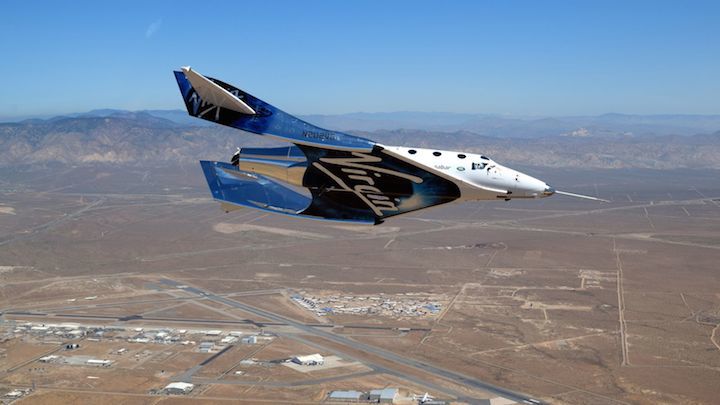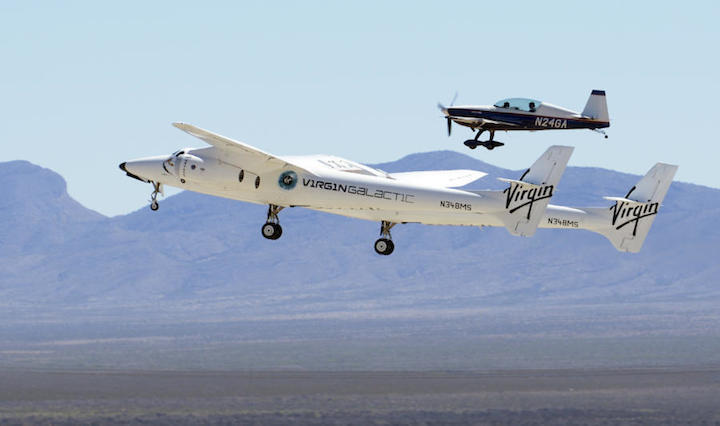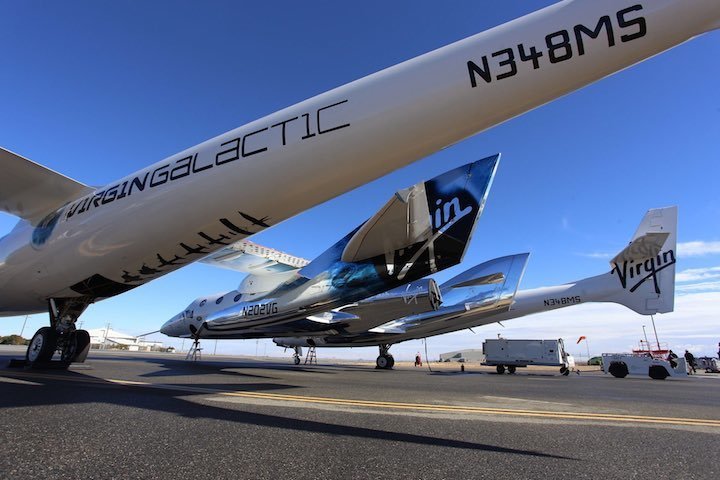10.06.2017
Virgin Galactic has given us a first glimpse of its would-be corporate space jet, SpaceShipTwo, in flight

Mojave Air and Space Port, California
The only problem was the wind, which had chosen this day to break its usual routine.
Out in the desert, mornings are typically calm, with winds building during the day. On June 1, at the Mojave aerodrome 90 miles (145 km) north of Los Angeles, the opposite happened: Strong winds in the morning postponed a planned test flight of Virgin Galactic’s SpaceShipTwo. Anxious technicians watched windsocks scattered around the aerodrome, which dispiritingly refused to agree on where the wind was coming from or how fast it was going.
SpaceShipTwo itself looks like a small, nattily-attired corporate jet with unusually elaborate wings. It is designed to hang from a carrier plane called a White Knight that soars nearly 50,000 feet (15,000 m) into the air. Then, SpaceShipTwo is released to ignite its rocket engine, roar up into space and, after hanging at the peak of its flight path for a few minutes, glide back down to earth to land on a runway. When it’s fully operational, Virgin founder Richard Branson expects it to carry six paying passengers on a 3-gee thrill ride to the edge of space.
Despite more than 12 years of development, the company has yet to put any passengers in its craft. It’s a testament to the challenge of developing a vehicle that can withstand the rigors of space. June 1 was one of only a couple of times the company has hosted reporters at a test flight since an accident in 2014 resulted in the death of one of the company’s test pilots, Michael Asbury.
The National Transportation Safety Board found that problems in the plane’s design turned a predictable mistake into disaster. Asbury had unlocked the plane’s rotating tail booms, or “feather,” at the wrong time, causing it to break up in flight; nothing prevented him from doing so. The vehicle’s original designer, Burt Rutan, a legend in aerospace—who won the Ansari X-Prize for sending the first privately-funded, crewed vehicle into space—had argued that “if space is going to be cheap, it has to be stick-and-rudder.” But investigators found that this philosophy put too much pressure on the pilot to operate flawlessly.
“During design, Scaled [Composites, Rutan’s company] did not consider the possibility that a pilot would unlock the feather before 1.4 Mach [1.4 times the speed of sound] and as such no safeguards were built into the feather system designed to prevent this,”an NTSB official said after the investigation. “Although program personnel said that they were aware that unlocking [the rotating wings] during transonic flight would be catastrophic, there was no warning, caution or limitation in the pilot operating handbook or test card that specified this risk.”
That accident accelerated a reorganization that had begun in 2012, when Virgin Galactic took complete control of the company manufacturing its airplanes and spacecraft. Previously it had been a joint venture with Scaled Composites. Now, Virgin Galactic would handle all aspects of testing and development itself. The company unveiled a new SpaceShipTwo, called VSS Unity, at the beginning of 2016, with new safety features. One of the company’s pilots, Todd Ericson, a former chief of safety for the US Air Force’s test-flight program, was appointed the safety lead.
Now, the newest incarnation of SpaceShipTwo is deep into its second attempt to be certified as safe for passengers. When will that happen? “When we’re ready,” says Virgin Galactic CEO George Whitesides. This is how they’ll get there.
Push the envelope

The wind eventually cooperates, dying down enough that the team can okay the test flight. This will be the ninth time that Unity has flown into the sky underneath its carrier airplane, and the fifth time it has been released to glide back down to earth on its own. As the White Knight prepares to taxi down the runway, white Range Rovers drive ahead to scare away birds and spot any debris that might interfere with takeoff.
Flight testing, Ericson explains, is a matter of expanding “the envelope”—the performance parameters for a vehicle. The team tests the simplest tasks the craft can perform, making sure the measurements from some 450 onboard sensors match their expectations, refining their predictive model about how the craft will behave under different conditions, then testing it again. This continues until the craft has been tested to maximum performance.
So far, executives say, the glide tests have been progressing as hoped for. A successful test of the feathered wing system a month before had given the design team confidence. The “feather,” which caused the fatal crash in 2014, is the most unique part of Unity’s design. Commonly compared to a badminton shuttlecock, it’s meant to be unlocked as the craft reenters the atmosphere from space. The wings’ tail booms rotate around the fuselage from horizontal to almost vertical, forcing the craft to return to earth belly-first, safely pushing away the heat and friction of reentry.
Such high-energy action is still many months away at this point. The test on this day is fairly simple: Making sure that the craft will still be aerodynamically stable when its heavy rocket motor is installed and the center of gravity has moved backward. To simulate this, the company has put in a special water tank weighing about 2,500 lbs (1,130 kg). The craft will maneuver with the full tank before dumping it and returning to land. Though it is gliding, the craft will go as fast as 0.75 Mach. A German-made stunt plane will follow closely behind, watching the process.
Mike Moses, Virgin Galactic’s president, is standing beside the runway with a crowd of employees (sample t-shirt: “Space is Virgin territory”) and family members. A radio earpiece connects him to mission control as he describes the flight test. The carrier climbs to 50,000 feet, far beyond the range of the naked eye, but as it moves to release Unity, it releases white contrails so it can be seen. The spacecraft is at first a dot, plunging from the sky.
And then a tiny puff of white appears next to the craft, prompting anxiety in the team on the ground. After a quick discussion, Moses explains that controllers had seen something they didn’t like during planned maneuvers and told the pilots to “knock it off”—that is, skip that step of the test. Later, we learn that the maneuver—one of 15 distinct steps in the 10 minutes or so of independent flight—had been a steep climb. During the climb, sensors found the forces on the plane exceeded the planned 2 gees, or twice the force of gravity, and the flight controllers told the pilots to quit. The spaceship is designed to withstand up to 4 gees, Ericson says. The puff of white was a little bit of water burping from the back of the tank.
The craft continues its glide above the airport, now clearly visible from the ground. At the appointed time, it dumps its load of water, spilling a white cloud into the sky.

After one more pass overhead, the craft glides in for a smooth landing on the runway. The Range Rovers rush out to greet it, one picking up the two grinning pilots and the other hooking up to the front of Unity, towing it away as easily if it were a rented trailer.
“Now the real work begins,” Ericson says. The test team immediately debriefs the pilots, and engineers will spend two to three weeks looking over the data gathered during the flight for anomalies. The test flight we have witnessed is just the most tangible aspect of the program, which began weeks ago with hours of practice in the simulator.
Into space

The previous version of SpaceShipTwo performed more than 20 glide flights over two and a half years before it began powered testing. Unity has flown five times in the last seven months. This seems to jibe with the Virgin engineers’ view that they can now move faster, thanks to the data they collected on the ill-fated previous vehicle.
The next steps will be to complete more glide tests to simulate more variables in flight—for example, how Unity responds aerodynamically to the sudden shift in weight when its rocket engine fires. The company will test this by doing a glide flight with propellant tanks installed but no combustion chamber; the tanks will rapidly dump propellant to partially simulate the effects of an engine burn.
But powered-flight testing still remains the biggest challenge, and while the company’s engineers have been refining their rocket engines in ground tests, it’s safe to say that there’s little chance of a passenger flight within the next year. Still, the Virgin team is already planning a mass exodus from its Mojave test center to the New Mexico spaceport that will host its commercial operation.
The company, once almost the only aspiring space tourism firm with the capital and engineering know-how to demonstrate a space vehicle, now faces new competition as well from Jeff Bezos’ Blue Origin, which has developed a reusable vertical-take off rocket and plans to begin flying humans as soon as 2018. It’s not clear yet how much each service will cost, but suddenly aspiring space passengers will have options. That doesn’t bode well for either company making back its initial investments, though both are backed by deep-pocketed billionaires and, in Virgin’s case, Abu Dhabi’s sovereign-wealth fund.
Whitesides, Virgin’s CEO and a former NASA chief of staff, understands this skepticism. Flying six people on tourist jaunts to space isn’t the end goal but “phase one of a bigger strategy,” he says. If the Ansari X-Prize that birthed this design was the equivalent of Charles Lindbergh’s prize-winning transatlantic flight, then SpaceShipTwo could be the equivalent of barnstorming pilots who flew planes around the country, demonstrating their capabilities to a wide range of people in a way that wasn’t obviously productive.
The next step is actually transporting people from point to point. Virgin has the somewhat contradictory reputation of being an earth-focused space company: Suborbital flights could drastically speed up long journeys, if the economics works. Such a business would need a new vehicle, but the lessons learned from developing SpaceShipTwo would help with that. And, Whitesides says, while the rockets built by SpaceX or Blue Origin may be good for reaching orbit, Virgin Galactic’s system will fit in much better when it comes to daily operations in airspace currently regulated for aviation.
But first, they need to expand the envelope.

Quelle: Quartz
---
Update: 8.01.2018
.
Virgin Galactic tests leading to rocket-powered flights

Virgin Galactic’s passenger rocket ship is gearing up for powered flights that could eventually carry paying tourists into space from southern New Mexico.
It’s the next critical step for SpaceShipTwo, which is moving from a series of glider flights that started in December 2016 to rocket-powered ones this year at the Mojave Air and Space Port in Southern California, said Virgin Galactic CEO George Whitesides.
“We’re about done with the glide-flight phase,” Whitesides told the Journal last week. “The next step is powered flights through an incremental process to test performance. Powered flight will push the vehicle into supersonic flight, and eventually to multiple times the speed of sound.”
That puts the company nearly back to where it was in October 2014, when its first SpaceShipTwo broke apart in a powered flight over the Mojave Desert. That accident set back the launch of commercial flights from New Mexico’s Spaceport America by years. Human error caused that incident after the copilot prematurely engaged the rocket’s braking system, tearing the vehicle apart in midair in an accident that killed the copilot and injured the pilot.
The new SpaceShipTwo is equipped with an automated lock mechanism to prevent such things in the future. And since 2016, it has flown nearly a dozen times, about half of them “captive carry” flights where the vehicle remains attached to the mother ship, WhiteNightTwo. The other half were glider flights, where the rocket detaches from WhiteNightTwo while in the air to descend on its own to the ground.
The glider flights have allowed Virgin Galactic to fully assess vehicle performance as it returns to earth. That includes testing the rocket’s “feathered” braking system, through which the ship’s wing booms are turned into position for re-entry from suborbit to permit the vehicle to gently glide down to earth.
Virgin Galactic teams have also tested vehicle handling at slow speeds with more weight on board, including shifts in the ship’s center of gravity for landing.
At least one more glide flight is planned for the coming weeks before moving onto powered ones. Once that happens, it thrusts SpaceShipTwo into a final-frontier phase where the rocket will shoot incrementally higher in successive tests until eventually entering space.
Under Virgin Galactic’s system, the rocket is carried on the underbelly of WhiteNightTwo to 50,000 feet. It then detaches, and pilots ignite the rocket propulsion to push the ship into suborbit at 327,000 feet, or 62 miles up, which is considered the edge of space.
“We’ll test all parameters of the vehicle in powered flights,” Whitesides said. “We’ll compare all metrics and performance with our analytical models to make sure that what we see in the real test-flight data is what we predicted in our forecasts.”
It’s not clear how long powered-flight testing will take, much less how soon the company could actually move to commercial operations at Spaceport America. But Virgin Galactic is now actively preparing for operational activity. It will move many of its Mojave-based employees and their families to New Mexico in the next few months, growing its local workforce from about 30 now to more than 100 this year.
“We will start to post positions and work with contracted suppliers for jobs that support commercial operations such as hospitality, facilities management, and operations,” said Virgin Galactic spokeswoman Christine Choi in an email to the Journal.
Virgin Galactic is also building more models of SpaceShipTwo, with two more rockets now under construction. The company envisions a fleet of five rockets and two mother ships, although that depends on flight demand from paying passengers.
“We’re hard at work on the next two space ships,” Whitesides said. “There’s still a lot more work to do, but those vehicles are coming together, foreshadowing our vision of having a fleet of ships.”
All the progress is generating excitement among Spaceport America enthusiasts.
“A lot’s going on,” Richard Holcomb, spaceport ambassador, told the Albuquerque Economic Forum in December. “It’s coming, it’s very imminent, and it’s going to happen.”
Holcomb, along with Dale Dekker of the architecture firm Dekker/Perich Sabatini and other supporters, created the nonprofit Ambassadors for Spaceport America to promote New Mexico’s commercial space industry.
“It’s a booster club to step up and help make this happen,” Dekker told the Economic Forum. “We believe New Mexico will become a global center for space commercialization and innovation.”
Spaceport America is actively recruiting more companies. Apart from Virgin Galactic, it’s signed up four more permanent tenants, including SpaceX, UP Aerospace, Exos Aerospace, and Energetic Pipeline2Space.
“Some are getting ready to move dirt and build hangers,” said Spaceport America CEO Dan Hicks.
Others, such as The Boeing Co., are testing new technologies at the spaceport, and more suborbital providers are also considering operations there, Hicks said.
Quelle: Albuquerque Journal
---
Update: 14.02.2018
.
Microsoft Edge boosts SpaceShipTwo into virtual space on Virgin Galactic’s website


Virgin Galactic hasn’t yet started taking tourists into space on its SpaceShipTwo rocket plane, but the company now offers a virtual SpaceShipTwo tour on its website, with a big assist from Microsoft Edge Web Showcase.
The upgraded website is a lot clickier — and continues to provide basic information about Virgin Galactic as well as videos, stills and online updates. But the centerpiece is a 3-D, VR-enhanced digital model of VSS Unity, the SpaceShipTwo plane that’s undergoing tests at California’s Mojave Air and Space Port.
Start your tour by tapping on the website’s “Explore” button.
If you’re plugged into a virtual-reality or mixed-reality headset, or looking through a smartphone viewer, you can use gaze controls to navigate your way through a 360-degree environment.
Focusing on hotspots will bring up videos and graphics about SpaceShipTwo, its WhiteKnightTwo mothership and the Virgin Galactic team.
There’s a parallel 3-D tour that’ll give you a similar experience even without the headset.
Microsoft Edge’s Divya Kumar and Virgin Galactic’s Tom Westray tell the story behind the extreme website makeover today in a posting on Microsoft’s Windows Experience Blog.
“Partnering with Virgin Galactic offered the Microsoft Edge team a unique opportunity to use web technology as a digital gateway to tell the story of the future of human space exploration through unique, exclusive and memorable experiences,” they write.
In a video about the project, Virgin Galactic Vice President Julia Tizard says she sees parallels between what her company is doing and what Microsoft Edge is aiming for.
“The spirit of what Microsoft Edge is bringing to the Virgin Galactic website is a very kindred spirit,” she says. “It’s the same creativity, the same innovation, the same storytelling mode that we have.”
Virgin Galactic’s story has had its low points and its high points, but now it’s about to enter a crucial chapter: the rocket-powered phase of VSS Unity’s flight tests, shooting for the edge of space.
The company says its schedule for commercial operations at Spaceport America in New Mexico will depend on how the test program proceeds, but hundreds of customers already have paid as much as $250,000 to reserve their ride.
For those would-be spacefliers, and for everyone else tracking Virgin Galactic’s progress, the remade website could well become a star on the list of favorites.
Quelle: GeekWire
